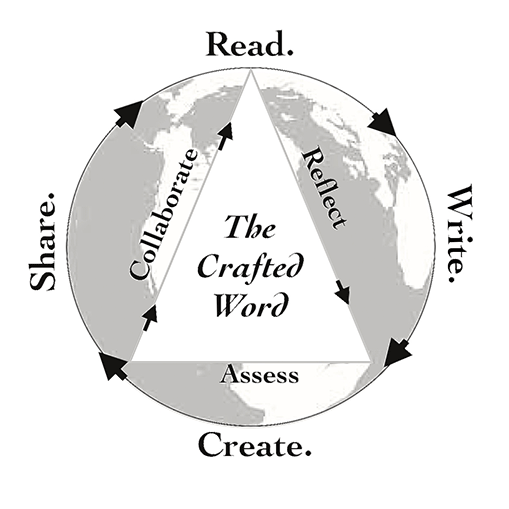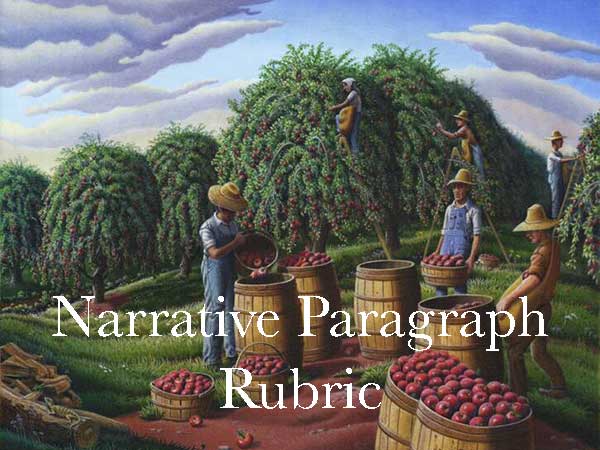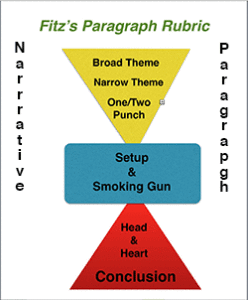TheCraftedWord.org

Tell Your Story
How To Write a Narrative Paragraph
Use the Narrative Paragraph Rubric to Help
Craft a Compelling Story from Your Life!
The Meaning of Paragraphs
Moreover, I, on my side, require of every writer, first or last, a simple and sincere account of his own life, and not merely what he has heard of other men’s lives
~Henry David Thoreau
If some alien linguists came to earth to study how we communicate with each other, they would probably return to Alien World University and tell their scholarly alien brethren how we create and assign words to our thoughts, and then we share these words either by sound (by talking with each other) or by changing those sounds into a strange and silent written language (written words) that tries to recreate the way we humans talk with each other. Further study would show that we group our thoughts (and hence words) into blocks that we call sentences and paragraphs. Sometimes we group a series of related paragraphs together into an essay, or a speech, or a story. In short, they might say that we communicate using a trinity of expression: a sentence is a thought fully expressed; a paragraph is a thought fully explained; while an essay (or any longer writing piece) is a thought fully explored.
The perceptive alien would notice that we humans have no difficulty speaking in sentences and paragraphs, but we sometimes have a heck of a time trying to do the same when putting our words into writing because most of us humans do not really know (or even have to care) what is and what is not a paragraph. But we should care, because a well-spoken or well-written paragraph adds detail, clarity, and beauty to even the most common thought. It is important to remember that a paragraph is always born in a single thought, and that paragraph ends with the original thought more fully developed and explained. In a way, a paragraph is like caterpillar that transforms into a butterfly. The original thought ends the same, yet different.
How long it takes for that caterpillar to become a butterfly is up to the writer. There is no minimum length for a paragraph. The maximum length is just before the writer drifts or shifts away from the original thought. Generally speaking, the more deep and complex the original thought, the longer a paragraph needs to be; however, if a writer is simply presenting the facts of a story (as in the news) the paragraphs are often remarkably brief–oftentimes just one or two sentences. In short, a paragraph simply needs to do what you (as a writer) need it to do.
All of this might fly in the face of those of you who have been told that a paragraph needs to be five sentences long, or have three supporting facts, or a topic sentence at the start, or it needs a quote. Really all a paragraph must do is explain, elucidate, expound, and/or explicate an idea, thought, experience, or fact—in short—much like a full essay—a paragraph simply needs unity, theme, and purpose. Once that is created after three, ten or ten hundred words, it is time to end the paragraph and move on to the next one or another one.
One of the ironies of my life as a writer is that I have always felt that writing is an organic process that tries to recreate the voice that speaks within us; but, here I am as a writing teacher creating all these “rubrics” and “formulas” to help my students write more effectively. My hope is that the rubrics will help them any aspiring writer find and develop that inner voice that is completely and uniquely his or her own.
This formula for narrative paragraphs is based on the way we would naturally talk about an experience we have had: we introduce what we want to talk about; we narrow it down to something specific and more focused; we offer proof that we have had the experience, feeling, or thought, and then we add some commentary or further explanation. Anything less than this and we run the risk of sounding disjointed, confusing, and random. There are no laws for writers, nor are there really any rules aside from what teachers or employers impose, but there is an audience out there, and if confuse them, you lose them. At the very least, if you try this formula, you will write a focused and logically structured paragraph; moreover, with a little bit more effort, you can write paragraphs that ring with beauty, clarity, and resonance!
So, here is my formula for writing a good narrative paragraph. In narrative writing we write about our own lives and thoughts and feelings, and so we write in the first person (except where noted).
This rubric is designed to help writers organize the flow and focus of a personal experience narrative paragraph. In a narrative paragraph, a writer writes from a personal point of view about something “worth writing about” in his or her life.
This rubric breaks a paragraph down into three areas:
- The first part of the paragraph introduces and narrow downs a theme from a broad theme (interesting and catchy enough to anyone) to a more narrow and focused theme that a writer can explore and explain in a single paragraph of 350 words or less, (but seldom less than 250 words).
- The central part of the paragraph (the setup and smoking gun) focuses on introducing and describing the experience that captures the essence and importance of your theme in a series of images and actions that tell the who, what, when, where, and why of the experience. (This is similar to text support or facts in expository or analytical writing). It proves the author has the authority and enough experience to write about this theme from the point of view of someone who has lived through the experience—and now has a story to tell that is meaningful, memorable—and above all, written with real and natural narrative voice.
- The last third of the paragraph (the head & heart and the conclusion or transition) explicates (which means to explain in detail) how the theme works within the experience the author just described. In the diagram you can see how the triangle starts small (narrow) and expands back towards a solid base. In practice, the writer should focus first on the parts of the experience that show the theme in action. Towards the end of the paragraph, the writer can (he or she does not have to) write about the importance of the theme in a more universal way.
- The closing line or transition will either be a brief and pithy conclusion or a sentence that transitions to a new paragraph that is logically linked together with the paragraph just completed.
NOTES
Read each section carefully to be sure you are following the flow of the rubric. A narrative writing piece needs to have the natural flow of human speech to be effective. If it is too choppy, it will be an ineffective piece because it won’t feel or sound real.
Remember that no writing piece is ever “done.” It is abandoned, and every minute before that time is a good time to “change” your paragraph for the better. Before you abandon this piece, let it sit for a couple of days, then go back to it with fresh eyes and a fresh mind and do what you need to do to make it more perfect—at least in your mind.
This rubric, if used wisely, is essentially a brief essay—and a damn good one if you give it the time and focus that well-crafted writing needs.
Example Prompt: The Power of Family
No matter how a family is created, it is, for better or worse, the most universal theme and common thread that binds us all together as humans. Every family develops its own dynamic, their own way of doing things that they borrowed from traditions, religions, cultures, and often trial and error; but the basic fabric of a family is the same the world over—it is a group of people who are somehow brought together and figure out what it means to be a family.
Think of your own family and use this rubric to write a one paragraph reflection on some aspect of your experience with your family that illustrates the theme of the power of your family in a single experience in your life.
STEPS OF THE RUBRIC: Read each section carefully and try to follow all of the steps of the rubric. Read each section out loud or use text to speech and proofread carefully. A narrative should “sound” just like you would speak. Except better.
Now get started on your own paragraph…
Some more cool tips & tricks to help you write well…
Henry David Thoreau
Write often, write upon a thousand themes, rather than long at a time, not trying to turn too many feeble somersets in the air–and so come down upon your head at last. Antaeus-like, be not long absent from the ground. Those sentences are good and well discharged which are like so many little resiliencies from the spring floor of our life–a distinct fruit and kernel itself, springing from terra firma. Let there be as many distinct plants as the soil and the light can sustain. Take as many bounds in a day as possible. Sentences uttered with your back to the wall. Those are the admirable bounds when the performer has lately touched the spring board.
(November 12, 1851)
Kurt Vonneghut
Vonnegut offers eight essential tips on how to write a short story:
- Use the time of a total stranger in such a way that he or she will not feel the time was wasted.
- Give the reader at least one character he or she can root for.
- Every character should want something, even if it is only a glass of water.
- Every sentence must do one of two things–reveal character or advance the action.
- Start as close to the end as possible.
- Be a sadist. No matter how sweet and innocent your leading characters, make awful things happen to them–in order that the reader may see what they are made of.
- Write to please just one person. If you open a window and make love to the world, so to speak, your story will get pneumonia.
- Give your readers as much information as possible as soon as possible. To heck with suspense. Readers should have such complete understanding of what is going on, where and why, that they could finish the story themselves, should cockroaches eat the last few pages.
James Joyce
Better pass boldly into that other world, in the full glory of some passion, than fade and wither dismally with age.
Ralph Waldo Emerson
If you desire to arrest attention, to surprise, do not give me the facts in the order of cause and effect, but drop one or two links in the chain, and give me a cause and an effect two or three times removed.
Annie Dilliard
Why are we reading, if not in hope of beauty laid bare, life heightened and its deepest mystery probed? Can the writer isolate and vivify all in experience that most deeply engages our intellects and our hearts? Can the writer renew our hope for literary forms? Why are we reading if not in hope that the writer will magnify and dramatize our days, will illuminate and inspire us with wisdom, courage, and the possibility of meaningfulness, and will press upon our minds the deepest mysteries, so that we may feel again their majesty and power? What do we ever know that is higher than that power which, from time to time, seizes our lives, and reveals us startlingly to ourselves as creatures set down here bewildered? Why does death so catch us by surprise, and why love? We still and always want waking.
~The Writing Life
The Power of a Narrative Paragraph!

1) The Major Theme
- Writing out your theme as a single word or short phrase is a good way to help keep focused as you write the paragraph.
- Put your one word or short phrase theme centered on the page.
- It should constantly remind you that THIS is the theme you have to stay focused on throughout your paragraph!
The Power of Family
3. GUIDING QUOTE
- If you are only writing a single paragraph, I think it is a great idea to put a quote above the paragraph that captures the mood, tone, and theme of your paragraph.
- The guiding quote helps to prepare your reader mentally for the coming paragraph.
For example: if I wish to write about The Power of Family, I could use a quote like this, put in italics, with the author’s name below the quote.
Home is where when you get there,
they have to let you in.
~Robert Frost
3. BROAD THEME:
- Write a short declarative statement that touches on a broad theme that all of us can relate to in some way or other.
- This acts as a “hook” that will attract your reader’s attention.
- Despite what you might wish, no one really cares about you when they read; a reader cares primarily about himself or herself.
- This broad theme is a theme that almost any person can relate to on some level, and hopefully it is intriguing enough to make your reader want to read on.
For example: if you want to write about the importance of family, here is an example of a broad theme:
- It is only our immediate family that gives us unconditional love.
4. NARROW THEME:
- Narrow down your theme by writing a phrase or sentence using the theme word that captures how your chosen theme is used in a specific way in the experience you are going to write about.
- Make sure it is “clear, concise and memorable” because this is what you want your readers to remember “as” they read your paragraph.
- This is the sentence that “steers” your reader in the direction you want your paragraph to go, and in that sense, it is what your paragraph is going to be about.
- YOU should be in this sentence; otherwise a reader may be misled into thinking you are merely writing about the importance of the theme, not about an experience you have had.
For example:
- It was my family that I turned to when I had no place left to go.
5. THE ONE/TWO PUNCH
- Follow your topic sentence with one or two more sentences that add detail or explanation to your topic sentence.
- These sentences can (and maybe should) be longer sentences.
- This helps to “narrow down” the focus of your paragraph so that you only have to write what can be fully explained in one paragraph.
For example:
- When I was alone in the world; when nothing was going my way, I knew that the door of family would always open for me and welcome me back into the arms of those people who love me without reservations.
6. THE SETUP:
- The setup is the lead-in to your smoking gun.
- It prepares your reader for the description of your experience in the smoking gun by giving context to the experience.
- Try to answer these questions.
- Who is there?
- What is happening?
- When is it happening?
- Where is it happening?
- Why is it happening?
For Example:
- At no other time in my life was this more obvious than when I returned to my family home in Concord after a long journey to China to discover the essential truth about life.
7. THE SMOKING GUN
- When writing about a personal experience, chose a specific personal experience (or even a smaller part of an experience) that explicates, illustrates, and amplifies the theme of your paragraph.
- This personal experience is proof that you have been there and done that, which is why we call it the smoking gun!
- It is evidence that you are the one who had the experience that only YOU can write about with full authority. When you write the smoking gun, be sure to include as much detail as needed—the who? what? when? where? and why?—to fully capture the theme of your paragraph.
For example:
- Broke, disheveled, and disenchanted, I stood on the doorstep and tentatively rapped on the door. No smile was wider than my mom’s; no arms were wider than my dad’s as they pulled me into their arms and into the living room I left so long ago.
7. THE HEAD & HEART
- Show your reader your thoughts!
- Write as many more sentences as you “need” (but at least three more) to illustrate and elaborate upon whatever you introduced in your theme-setting sentences.
- This is where you reflect upon your experience and describe the ways that your experience reflects your broad and narrow theme.
For example:
- It didn’t matter that I left home without even telling them where I was going. It didn’t matter that I had once criticized their lives as dull and meaningless, and it didn’t matter that I never called and never wrote. It only mattered that I was home again with my family.
9. CONCLUSION:
- The closing line or transition will either be a brief and pithy conclusion or a sentence that transitions to a new paragraph that is logically linked together with the paragraph just completed.
For example:
- For me, it only matters that I will never turn my back on my family again because when times are tough, family is all that really matters
THE PROOFREADERS RULE OF THREE:
- Literature is abandoned, not finished! Go back and re-read what you have written.
- Find three areas or sentences that you can make better. If you can’t or won’t do this, then you are light years away from being a writer.
- Often you can find a better broad or narrow theme sentence somewhere else in the paragraph. You can almost always find a more clear and effective way to write a sentence than you wrote on your first try.
- If the rule of three was too easy (meaning you easily found mistakes) do it again…and again if you have to.
- When you are convinced you have done all you can, submit your final review as required by your teacher or editor.


